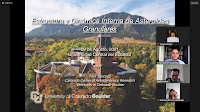Conferencia 3 (2021)
Dr. Paul Sánchez, Ph.D.
(Colorado Center for Astrodynamics Research, University of Colorado Boulder, USA)
Título: Estructura y dinámica interna de asteroides granulares.
Lugar: Plataforma ZOOM, ID: 97284065370.
Fecha: Lunes 09 de agosto de 2021.
Horario: 16h00 - 18h00.
Resumen: Durante los últimos 20 años de investigación sobre la expiración de asteroides y cuerpos menores del Sistema Solar, se ha llegado a la conclusión de que estos cuerpos son agregados granulares, es decir, cúmulos de rocas, piedras pequeñas y polvo que se mantienen en equilibrio mecánico debido a fuerzas de atracción gravitacional principalmente. El comienzo de la era espacial y la puesta en órbita de satélites también dieron lugar al descubrimiento del efecto de la presión de la radiación solar en la velocidad de rotación y en la órbita de cuerpos pequeños. Estos son los efectos de Yarkovsky y YORP, el segundo de los cuales tiene la capacidad de acelerar la rotación de un asteroide. Sin embargo, si fuera solo la gravedad la que mantiene la estabilidad mecánica de un asteroide, todos, impulsados por el efecto de YORP, deberían tener un mismo límite para su periodo de rotación. No obstante, se ha notado que asteroides pequeños (<150 m), pueden rotar a velocidades mucho mayores de lo que el límite gravitacional lo debería permitir. En esta charla, hablaremos de algunos de los métodos que hemos utilizado para analizar este tipo de asteroides, las predicciones que se han podido hacer, lo que hemos podido observar en algunas de las últimas misiones espaciales y lo que hemos podido aprender de los asteroides visitados.
Dr. Paul Sánchez obtained his undergraduate degree in Pure Physics in Ecuador while doing research in Computational Quantum Chemistry, he then obtained his Ph.D. degree at the University of Nottingham in England in the the field of Granular Dynamics, after which he did his postdoctoral training at the Université de Rennes 1 in France studying confined granular flows. After this, for a short period of time, he worked for the Ecuadorian government at the former National Secretariat of Science and Technology (today SENESCYT) as a Department Director in charge of scholarships and international contact. It was during this period of time that he was hired to work with Prof. Daniel Scheeres at the University of Colorado Boulder and was finally introduced to his current field of research in Planetary Sciences. Due to this unusual professional trajectory, he has gained extensive working knowledge about three very different scientific fields as well as about the administration of science. During his stay at CU Boulder he has worked in collaboration with researchers at the Southwest Research Institute, Ball Aerospace Corporation, Lockheed Martin, The University of Nottingham, The University of Montpellier, The University of Central Florida, The University of Maryland and NASA Ames, among the most important. He was also a research associate in the NASA OSIRIS-REx mission, becoming a collaborator in December, 2018, and is part of the Science Team in charge of the Strata-1 experiment in the International Space Station which will soon be open to other researchers as the “Hermes facility.” At the moment, his main research focus is the study of small asteroids as granular media in micro-gravity conditions which has allowed him to be part of the Sample Analysis Readiness Test team that will analyse the sample that will be arriving from asteroid Bennu. Binary asteroid 20882 (VH57) has been renamed 20882 Paulsánchez due to his contributions to the field.
Fotos:
Video:















No hay comentarios.:
Publicar un comentario